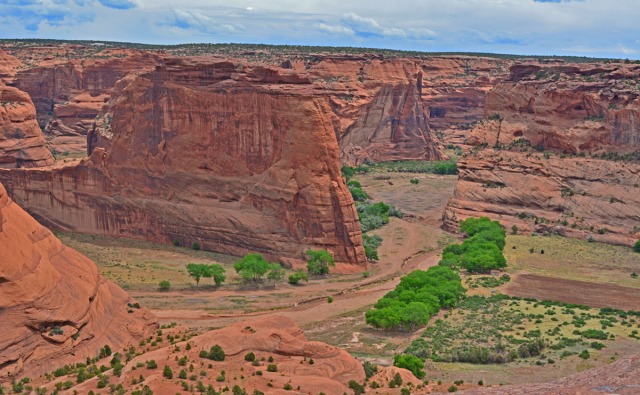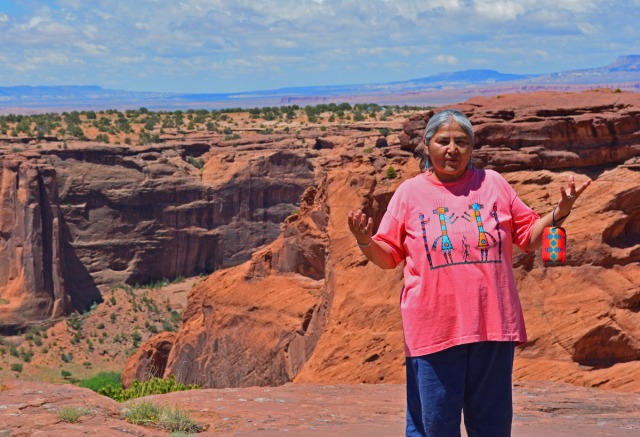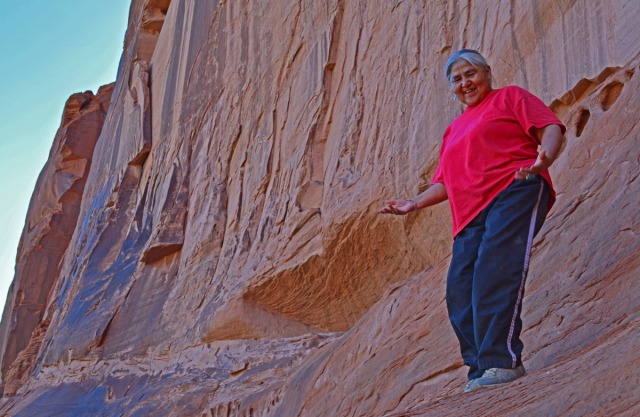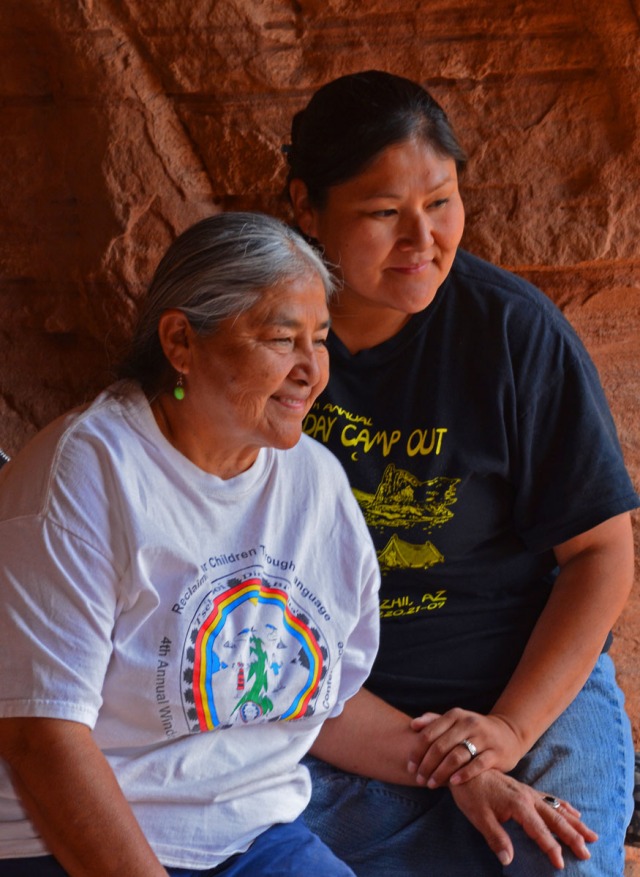Having just spent a week at the bottom of Canyon de Chelly (pronounced like “Shay”) in North Eastern Arizona, I was re-introduced to the ancient art of storytelling.
Our hostess was Lupita McClanahan, a Navajo or Diné woman who has a summer home in the Canyon. (Navajo is the name given to the Diné tribe by the Spanish. The word Diné is pronounced Dee-nay, with the emphasis on the second syllable).
Since the Canyon has no electric power and is free from cell phone interference, our evenings were spent around the camp fire, often listening to Lupita tell stories about her culture and her history. Oh, the stories she can tell!
After everyone was settled in their camping chair and the fire threw a soft light over our faces, she began. She spoke about the four clans by which each Diné identifies him- or herself, her father who had two wives (who were sisters) and her many siblings. She explained family relationships and tribal ways, talked about the main ceremonies in a women’s life: Birth, Puberty, Marriage, and Menopause.
We learned about Diné cosmology, the Holy People (called the Yei-be-che), especially Talking God and Spider Woman. For the Diné, everything is alive: the Rocks, the Clouds, the Rain (there is a male and a female rain), the Rivers, the Wind, and the Plants. Being in alignment with the Gods and natural forces around us is called following the Beauty Way.
You never knew how long Lupita’s storytelling would last. Each story took its own meandering course, un-ruled by Western time concepts. Sometimes she would pause and let more memories come to her, then continue her story. Her eyes looked into the far distance, as if she was reading her tribal memories from a large book somewhere in the skies. Sometimes, she would drop into her native Navajo language, perhaps to remind herself of the essence of what she wanted to say before translating it into English, her second language.
I loved the sound of Navajo even though I couldn’t understand a word. There were even a few click sounds in it. By the end of our stay, we all knew to say “Ya-a-te” (a greeting) and “Hagonee” (“Walk in Beauty” as a goodbye).
While the stories of Navajo (or Diné) culture were fascinating, our emotions were truly tested when Lupita told us about the historical events that happened to her people through several centuries of first Spanish, then US government, persecution and attempted genocide. Stories of homes and crops being burnt, people butchered when they resisted, orchard trees cut down, and people being starved to the point where they either threw themselves off the cliffs or surrendered to the white soldiers on horses. During “The Long Walk” (1864-68), about 8 or 9,000 Navajos were marched 400 miles to a place called Bosque Redondo, New Mexico, and kept imprisoned there. Many people could not adjust to the meager rations of unfamiliar foods or grow their familiar crops in the arid ground and died. When the government didn’t know what to do with the dwindling group of survivors, they gave them a few tools and animals and sent them back to their native land. Only a small number returned to the Canyon. Many couldn’t bear the sight of their homes and crop lands destroyed and settled elsewhere.
But the people re-built and expanded their numbers. Today, there are over 300,000 Navajos living on a large reservation territory. Many more moved away and live in other states.
Lupita’s story of the Long Walk was difficult to listen to – shame, guilt, anger, and sadness shadowed our faces as we listened intently to her story which has been passed down the generations for close to 150 years now. This was so very different from reading about these events in a history book. This story was told with understated passion but with palpable sorrow and an underlying question mark: Why did this happen? What was the point of it all?
Even after the Navajos were allowed to return to their homeland, they were never safe from the clutches of the Government. Lupita told of being snatched away from her grandparents’ home when she was about 7 years old. A green truck came into the Canyon and took all the young children they could find. Lupita’s grandmother had hidden her successfully for two full years, but this time, they caught her.
The children were driven to boarding schools, some as far away as Oklahoma or California. Their long hair was cut, they were given white people’s clothing, white people’s food, and punished when they spoke their native language. Lupita said that this was one of the worst times in her life. She was kept in boarding school for 3 years and, throughout that time, did not know when she would be allowed to return home. Sometimes she felt like she would die because she was so homesick for her beloved Canyon home.
One of her sisters, at age 6, was placed in a boarding school near the Canyon. She hated it so much that she ran away and found her way home, walking through the night and chanting songs to protect herself against wild animals.
Some of Lupita’s siblings were gone for 10 or more years. When they finally returned, they no longer looked and behaved like Navajos. However, Lupita was determined to return to her culture and share it with anyone who was interested and would listen to her stories.
Mainly, now, she wants to teach young people about the Diné culture. Like everywhere else, Navajo kids are exposed to TV and smart phones. Some of them only speak English and cannot understand their Elders communicating in the Diné language. Lupita dreams of taking a group of youngsters into the Canyon for the summer and teaching them to grow traditional foods, speak their native language, and learn the secrets of the Beauty Way. She would be their main teacher, guide, and story teller.
If only there was a grant that could help her fulfill her vision!
More information about Lupita McClanahan and her work is available at http://www.footpathjourneys.com.
More writings on Lost Arts can be found at The Daily Post’s Writing Challenge: Lost Arts.






What a truly important post this is, Annette. You have touched on something that should concern us all. We have a choice (if by the skin of our teeth) – the Westernized Consumer Way or the Beauty Way. This is one of the reasons why I write the kind of fiction that I do: we lose the wisdom of traditional cultures at our peril; they speak to the heart, mind and spirit. Techno-culture has its uses certainly, but we need to understand its limitations, and ultimate sterility. But more than anything we need to learn to value the understanding of peoples who have lived in ways that respect and honour the planet and all its living things – animate and ‘inanimate’. And when you think about it, there is nothing that is not living in some sense – it is part of a process; part of the great on-going story of recycling existence. Thank you. I needed to read this at this moment in time.
LikeLike
Oh, Tish, so good to hear from you. My insights while in the Canyon revolved around how dis-connected most of us have become as city and suburb dwellers. When we no longer live with the seasons, no longer grow our own food, no longer sit in nature and listen to the wind and bird and insect sounds around us, we have become rootless. We have become detached from the Big Mother that nurtures us all. And then it’s so much easier to use a bit of toxic Round-up to spray on “weeds”, or flush chemicals down the toilet, or throw things “away” (as if there was an “away”) because we no longer see the direct consequences on Nature, not immediately anyways.
I was filled with such a profound silence in that Canyon and so deeply re-connected to the Earth that I could care less if I ever saw electricity or a computer again. But more than that, in that profound silence, the ancient wisdom arises and can be heard….
Do you have a link for me to your fiction, are they on your blog?
LikeLike
Gosh, Annette, you sound to have had a very deeply rooted experience. As to my stories, there are links to my books on my blog under ‘Books’. They are mostly very short mini novels for unkeen teen readers, but with adult issues. Stone Robbers – set in Guatemala (where I’ve never been) most directly deals with the loss of traditional culture. Mau Mau Brother – another quick read coming out in Sept is about 1950s uprising in Kenya and the forest fighters. I am though planning something large-scale about an old African medicine man. In the meantime, my latest blog post ‘Vulcanicity’ is about colonial settlers not understanding the land upon which they imposed their laws of ownership.
Thanks again for this great post. I will re-read it. Tx
LikeLike
What a beautiful looking lady…..
The sad story of their persecution reminded me so much of the stories about the highland clearances. Old men and women in their nineties marched off their land, their houses burned their livestock butchered. They were forced to the fringes of the shoreline where the soil was thin and poor, or shipped off to the new world. Tartan was forbidden, and Gaelic was banned as a spoken language. Entire glens were stripped of their populations, and all just over 200 years ago!
History leaves us with some shameful stories to be faced……
LikeLike
Yes, these stories have been repeated throughout the world and unfortunately, haven’t stopped. How many millions of people are living in refugee camps right now, forced to leave their land and familiar way of life behind. It is the on-going sad story of humans on this planet…
LikeLike
Amazing! I’m glad you shared and look forward to more posts about this beautiful canyon.
LikeLike
So glad you came over to read it. Maybe one day you’ll go there yourself?
LikeLike
Awesome and informative post. How well you evoke a sense of place and time. Beautifully done. I especially love the profile shot of Lupita. Looks just like an R.C. Gorman painting.
LikeLike
Isn’t she a beautiful woman, so full of dignity in the face of so much adversity (more stories to come)….Thank you for your comment, Barbara.
LikeLike
Ya-a-te, Annette. This story was heart warming, yet at the same time heart wrenching. Lupita has a gift and I’m grateful that you shared some of her stories with us….the good and the bad. We just returned from a month in Ecuador, where I became fascinated with the indigenous Quechua people of the Andes Mountains. Researching the history of these people, I discovered that during the 60s and 70s, many of the Quechua women were sterilized without their consent. The worst part about the story is that the sterilization was administered by the Peace Corps and funded by the U.S. government and the Rockefeller Foundation. This horrifies and saddens me. No matter how difficult it is to hear these stories, we must always remember and pay tribute to their fortitude and perseverance. Hugs!
LikeLike
Wow, wow, wow….that is so disturbing. What right did they think they had to do this? It is deeply disturbing to hear this…and knowing that similar covert actions are being practiced even today. We are trashing the planet, so many of us modern folks are rootless and without real purpose but running on a hamster wheel to acquire material things and thrills…..there is so much we can learn still from indigenous cultures even as they are fading away to the blandness of modern ways.
Hagonee – Walk in Beauty and thank you for sharing your experience.
LikeLike
What a marvelous experience, Annette. Lupita has such a peaceful radiance about her. I’m sure she held you all spellbound with her stories.
LikeLike
Hi Sylvia – she did! She is such an amazing woman and we all fell in love with her. Since it was a women writer’s retreat, there were no men around, so she really got to shine. I was there several yrs ago, in a co-ed group, and didn’t get to know her nearly as well.
We did miss the men, though, because we didn’t realize just how much hard work they did for all of us (fire wood, carrying water, and other camp duties) 🙂
LikeLike
Thank you for sharing this experience and a bit about Lupita. We get so caught up in the information age and easily forget there is “Life” out there to be lived.
LikeLike
Thank you, MoonDustWriter. I so agree with you. Lupita’s storytelling was such a gift (and education).
LikeLike
Pingback: Lost Art #art #poetry #writingchallenge | Moondustwriter's Blog
You wonder what we were thinking during those years. What made the carnage okay? Probably the same mindset that makes war okay today. In the minds of some.
LikeLike
Carol – yes, it is the same mindset that has not changed. If you want something, you find justification and rationalization (even manufactured evidence for weapons of mass destruction) to go to war: land, oil or other resources deemed critical to your nation’s (elite) survival, maintaining control in a particular region, you name it….
LikeLike
As urbanites, we become ungrounded. Thanks for the grounding. Great article.
LikeLike
Thank you, Diana, glad to hear this was helpful to you.
LikeLike
Thanks for sharing this…what a wonderful experience and important reminder. We’re all storytellers…we just have to keep sharing.
LikeLike
Beautiful and thought provoking article. I went down into this same canyon in my early 20’s but just for a day. I would love to go back and experience the storytelling and history. Thank you for sharing your experience!
LikeLike
Hi Megan, I hope you’ll have a chance to go back and stay a while…
LikeLike
I will for sure. Was the trip you went on with a group or was it something available to the general visitor?
LikeLike
Megan – I was part of a small group. If you follow the link I gave at the bottom of the blogpost, you can go to Lupita’s website and find out more about the possibilities. The general visitor is only allowed to hike in to White House ruins and then has to hire a guide to continue further into the Canyon. Overnight stays require special permission and hosting by a Navajo family.
LikeLike
What a fascinating experience you had. It surprises me how little of this part of American history is being taught in schools still today. As if it never happened. It’s interesting, yet very sad and disturbing, how many countries rewrite history to make themselves look better. It’s great you got to hear from a first-hand perspective.
LikeLike
I love that farewell “Walk in Beauty”. Much more beautiful than the old goodbye.
LikeLiked by 1 person
Wonderfully moving post. There is so much the modern world could learn from people like Lupita – if only it would stop and listen a while.
LikeLike
Pingback: Canyon Memories (2): Wild Cactus | The Beauty Along the Road
Pingback: Taxing Taxes | litadoolan
What a stunning experience. I am so thrilled you shared this. A great read!
LikeLike
Thank you, Lita, very happy you enjoyed the essay.
LikeLike
Beautifully written story and amazing images. Thank you for this….and for the reminder that our indigenous peoples have so much to teach us – if we would only listen…and you did!
LikeLike
Hi Gaye – thank you so much for stopping by and leaving your comment. and now we are following each other 🙂 Welcome and looking forward to being inspired by your posts…
LikeLike
I’m sure it must have been very powerful and moving to hear Lupita’s stories. What abuse American Indians have suffered in the history of our country. It sounds like an amazing experience.
LikeLike
Wow, what a lovely experience.
We have similar stories in Australia. There is a book and a movie called “The Rabbit Proof Fence” written by an Aboriginal woman, about how she escaped the boarding school and returned to her Homelands, walking 2,400 kilometres through the desert.
LikeLike
Oops, Tree Girl, I just left a comment on your blog about this comment. I couldn’t “approve” it at first, sometimes WordPress does weird things (or maybe it’s me?). Yes, I saw that movie. It was incredibly moving and sad and has so much similarity with how Native American children in the US were treated into the 60s. Thanks for reminding me of that powerful movie.
LikeLike
Pingback: Thank you, World. | The Beauty Along the Road
What a great post. As you indicated, I have heard these details before from a dry historical perspective, but what a wondrous treasure to have heard the story from a Dine Grandmother. It is unfathomable to me what all “we” did to the native peoples in the name of progress.
LikeLiked by 1 person
Yes, my thoughts as well…
LikeLike